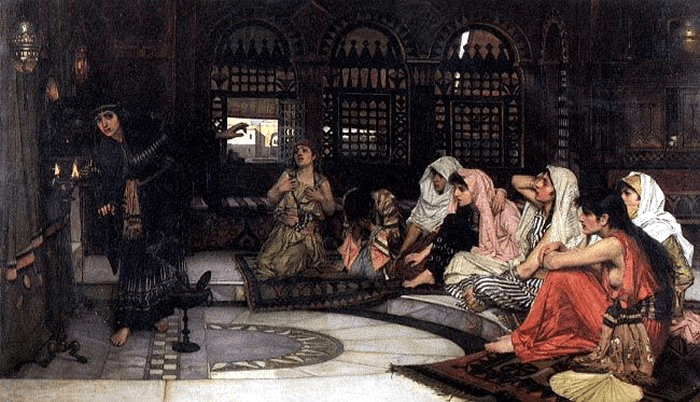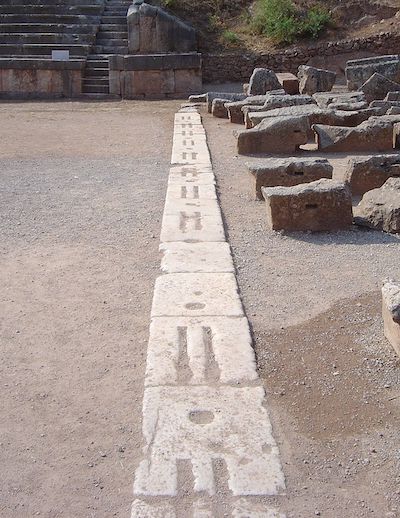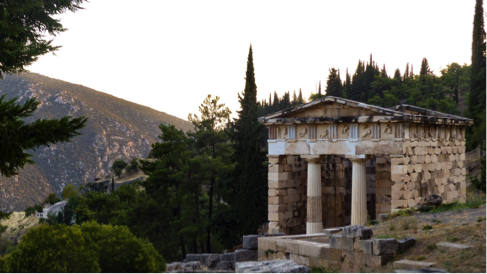By Edward Whelan, Contributing Writer, Classical Wisdom
Delphi was an important religious, social and cultural center in Ancient Greece. It was one of the few places where the Greeks came together; indeed, Delphi was crucial in their collective identity. This religious site played a critical role in Greek politics, which meant that a number of wars were fought over its control.
The History of Delphi
In Greek myth, it was believed that Delphi was the center of the world, known as the navel of the earth, ‘omphalos’. From the Late Bronze Age the location was a religious sanctuary, the site of an oracle, and archaeological evidence suggests that the Mycenaeans had a temple dedicated to the Mother Earth goddess here.

The omphalos in the museum of Delphi
Later, it was dedicated as a sanctuary to Apollo, the god of light, poetry, and reason, as it was believed that the god killed the giant serpent Pytho at the location. This sanctuary became famous for having a female priestess who was inspired by the god and gave oracles. The Oracle at Delphi had enormous prestige and was consulted by many important persons from all the different Greek city-states. Visitors from all over the Greek world came to Delphi to honor the god Apollo, and the Athenians consulted the oracle during their wars with the Persians.
While the oracle’s advice was often heeded, there were also suspicions that the oracle was bribed to provide an answer that was advantageous to some political leader or group.

Consulting the Oracle by John William Waterhouse, showing eight priestesses in a temple of prophecy
Delphic Games
Delphi was the location of one of the four Panhellenic Games, which included both athletic and non-athletic events in honor of the god Apollo. There was track, chariot racing, horse racing, wrestling, boxing and even musical contests. Greeks from all over the Mediterranean and the Black Sea would attend these Delphic or Pythian games, and in fact, the various City-States entered into a truce so that their athletes could participate.

This starting line at the Delphi stadium used for the Pythian Games at Delphi, Greece, has a design representative of that of many ancient Greek stadiums: stones with two lines in which the athletes nudged their toes, and round holes in which posts could be erected to support the start signalling mechanism.
History of Delphi
There is little of the history of Delphi before the 6th century BC. It was originally inhabited by non-Greeks but around the 6th century BC, the Phocians conquered the area and took control of the shrine. This site was very important, not only for its religious and cultural prestige, but also because of its vast wealth. The treasury of Delphi was overflowing with gold and silver, donated by pious pilgrims.
Delphi was reclaimed by the Athenians during the First Sacred War (597–585 BC). They established the Amphictyonic League, a political alliance designed to protect Delphi, but it later came under the control of some Athenian exiles. During the Second Sacred War (449–448 BC), which was part of the 1st Peloponnesian War, the Phocians were able to regain control of Delphi.
The Phocians gradually lost control of the sanctuary and this led one of their leaders to act out and seize its treasury. This led to the Third Sacred War (356–346 BC) between a coalition led by Phillip of Macedon and the Phocians, resulting in the destruction of the Phoceans and the rise of Macedon, who effectively came to dominate Delphi.
In the first century BC, the Thracians raided and sacked Delphi, stealing the temple’s sacred fire. The location was also badly damaged later by an earthquake. These events, as well as inaccurate prophecies, led to a decline in Delphi.
The sanctuary was once more revived in the 2nd century AD, under the patronage of Emperor Hadrian. The oracle continued to flourish even after Constantine the Great made Christianity the new religion of the Roman Empire. The Pythian Games continued to be held and remained popular. Eventually as Christianity became more prominent, the sanctuary declined. It was possibly closed by the command of Emperor Theodosius the Great.
Ironically, Delphi, the center of classical Greek religion, later became a major Christian center. It is believed to have flourished until the Avar and Slav invasions of Greece in the 8th century AD. Delphi was probably fully abandoned by 900 AD.
The Architecture of Delphi
In its heyday, Delphi was a complex of buildings and facilities, most of which were built by Greek City-States. There are many remarkable architectural remains still to be seen at Delphi. One of the most astonishing is the Temple of Apollo, which dates from the 4th century BC. It was built in the Doric style and is believed to have been the 6th temple built on this site. All that remains is an outline of the walls and rooms and a colonnade of broken columns. There was once a large number of votive statues at the shrines in Delphi and some of these can still be seen.
Delphi was once enclosed by walls. Upon entering the sanctuary, there were a number of treasuries, and one of these, the so-called Athenian treasury, has been fully restored by modern archaeologists. The stoa of the Athenians consisted of an open public space that was a covered walkway or portico, constructed by donations made by Athens. Many of the columns of the stoa, as well as its paved floor, can still be seen.
There was a theatre set into the hill at Delphi, built in the traditional Greek style, and it is very well preserved. The Tholos of Delphi was a circular temple and much of this remarkable building, which comprises of a number of Greek styles, has been restored. There are also a number of remains that were associated with the Pythian Games and they include the stadium and the hippodrome.
Delphi Today
Delphi is now a UNESCO World Heritage site and there are still archaeological excavations being conducted in the area. It is now a very popular tourist destination.
References
Dempsey, T., Reverend, The Delphic oracle, its early history, influence and fall, Oxford: B.H. Blackwell, 1918














One comment
It’s great to be here with everyone, I have a lot of knowledge from what you share, to say thanks, the information and knowledge here helps me a lot. shell shockers
Trackbacks
Our apologies, you must be logged in to post a comment.